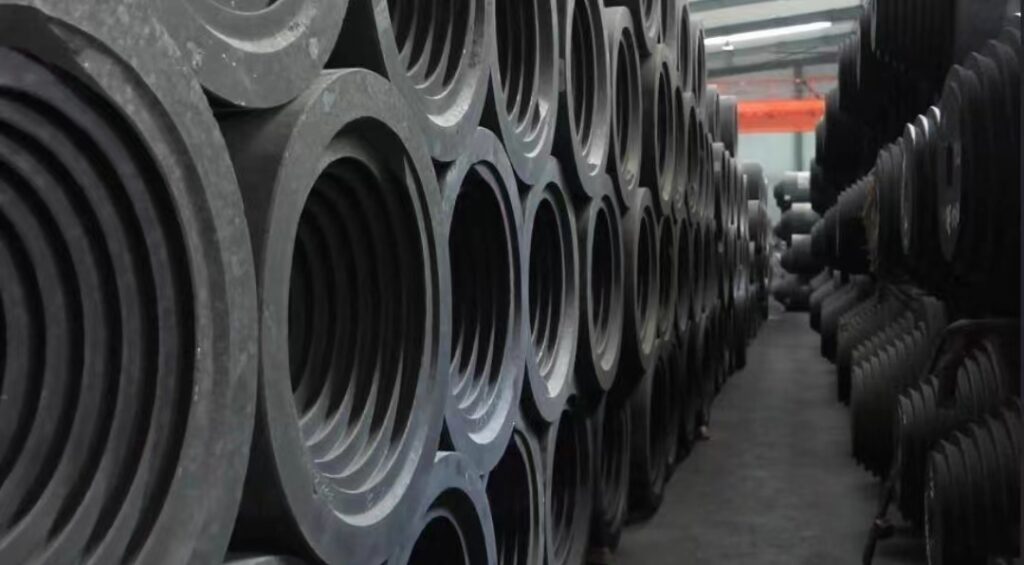Qu'est-ce qu'une électrode de carbone ?
En tant qu'électrode conductrice pour four à arc submergé, l'électrode de carbone est largement utilisée dans le processus de fusion de métaux ou de non-métaux tels que le silicium industriel, le ferro-alliage, le carbure de calcium, le phosphore jaune, etc. Il s'agit d'un matériau conducteur au carbone composé d'anthracite calciné à l'électricité, de coke de pétrole, de fragments de graphite, de brai de goudron de houille, etc. en tant que matières premières principales, par dosage, moulage, torréfaction et traitement mécanique.
Table des matières
Toggle
Quels sont les types d'électrodes de carbone ?
Les électrodes de carbone peuvent être divisées en deux catégories en fonction de leur environnement d'application : La qualité S est une électrode de carbone ordinaire, adaptée aux fours à arc submergés pour la production de silicium métallique, de phosphore jaune, de ferroalliage, de carbure de calcium, de corindon et d'autres produits ; la qualité G est une électrode de carbone spéciale, adaptée aux fours à arc submergés avec une charge de courant élevée.
Caractéristiques des électrodes en carbone
Faible résistivité.
Faible autoconsommation des électrodes.
Densité volumique élevée.
Faible teneur en cendres.
Bonnes propriétés antioxydantes.
Une économie d'énergie significative.
Les avantages des électrodes en carbone.
Tout d'abord, la production d'électrodes en carbone ne nécessitant pas de processus de graphitisation, son coût est inférieur à celui des électrodes en graphite.
D'une part, le coût de construction de l'atelier de graphitisation est élevé. D'autre part, des questions telles que les coûts d'expansion et l'alimentation électrique se poseront à l'avenir. En outre, la graphitisation consomme beaucoup d'électricité. La consommation d'énergie par tonne de produit est de 4 500 kWh, et chaque kilowattheure est calculé à 0,08 USD, ce qui augmente le coût par tonne de 373 SUD. Par conséquent, l'électrode de carbone n'a pas besoin d'être graphitisée et son prix est également inférieur à celui de l'électrode de graphite.
Deuxièmement, sur un four à arc submergé de même capacité. Par rapport à l'électrode en graphite, le diamètre de l'électrode en carbone peut être plus grand.
L'électrode de carbone de Φ780-Φ1400mm peut être fabriquée, et l'électrode de carbone de Φ780-Φ1400mm peut être fabriquée. électrode en graphite ne peut être que de Φ700mm. Cela permet d'élargir la bande d'arc dans le four, de stabiliser l'arc et de garantir l'efficacité de la fusion à chaud. Par conséquent, le rendement du produit est augmenté et la consommation d'énergie du produit est réduite.
Principales utilisations de l'électrode de carbone
Les électrodes de carbone contiennent du graphite, qui est également un bon conducteur d'électricité et peut fondre les métaux à haute température.
Dans le domaine de l'électrochimie, il est utilisé dans les batteries pour participer au processus de charge et de décharge. Les électrodes de carbone étant inertes, elles sont réduites pour produire des composés organiques et des métaux électrodéposés dans des réactions chimiques.
Dans l'industrie électrolytique, les électrodes de carbone sont utilisées dans les processus électrolytiques tels que le traitement de l'eau et la galvanoplastie.
Soudage et gougeage : Dans ce processus, la chaleur de l'arc est générée entre l'électrode de carbone et le métal pour compléter le soudage et le découpage.
Par rapport à la pâte d'électrode
Les électrodes de carbone peuvent améliorer l'efficacité thermique des fours à arc submergé pendant leur utilisation. Elles permettent notamment de raccourcir le temps de fusion et d'augmenter le rendement. De plus, il est facile de produire des électrodes creuses en carbone. Les entreprises de ferro-alliages peuvent ainsi ajouter diverses matières premières à tout moment.
En outre, le pâte d'électrode est chargé dans l'enveloppe de l'électrode installée sur le four pendant l'utilisation. Une grande quantité de fumées d'asphalte est émise au cours du processus de production, ce qui pollue gravement l'environnement et affecte la santé humaine. La tendance générale est à l'économie d'énergie et à la réduction des émissions. Il est donc impératif de remplacer la pâte d'électrode à forte consommation d'énergie par des électrodes en carbone.
Enfin, l'électrode de carbone n'est pas facile à briser en cours d'utilisation, et la rupture douce peut être éliminée, et sa perte non naturelle est moindre.
Conclusion
Électrodes en carbone, comme électrodes conductrices pour les fours à arc submergé. Elles permettent de mieux réduire les coûts, d'économiser de l'énergie, de réduire les émissions et d'améliorer l'efficacité de la fusion.


